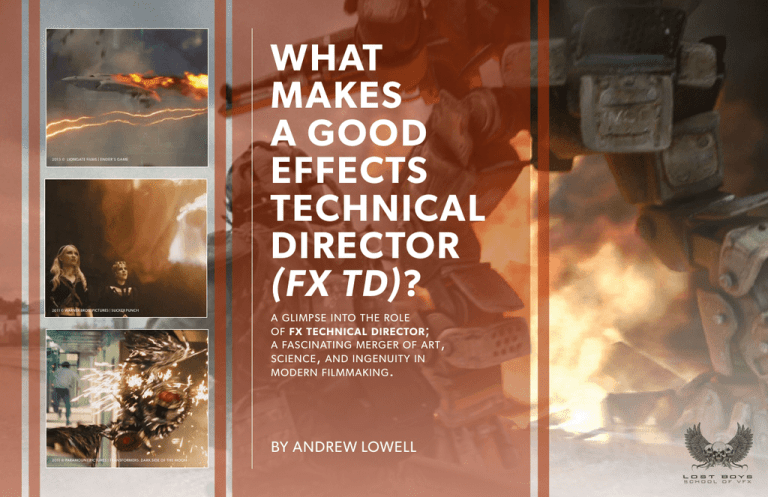what makes a good effects technical director (fx td)?
advertisement

2013 © LIONGATE FILMS | ENDER’S GAME 2011 © WARNER BROS. PICTURES | SUCKER PUNCH WHAT MAKES A GOOD EFFECTS TECHNICAL DIRECTOR (FX TD)? a glimpse into the role of fx technical director ; a fascinating merger of art , science , and ingenuity in modern filmmaking . BY ANDREW LOWELL 2011 © PARAMOUNT PICTURES | TRANSFORMERS: DARK SIDE OF THE MOON a n d r e w low e l l i s a n experienced effects t e c h n i c a l d i r e c to r . He has created effects on many projects in both feature film and television; at various visual effects studios around the world such as Rhythm and Hues, CIS Vancouver, Animal Logic, and Digital Domain. Training, education, and writing are some of Andrew’s long standing passions, as he also performs on-site training for both students and professionals worldwide. He resides as the program chair and instructor for the FX department at Lost Boys School of Visual Effects. THE MASTERY OF MOTION making feature film fx is all about understanding and controlling the visual motion of the element . THE ABILITY TO VISUALLY ANALYSE THE PROGRESSION OF AN EFFECT IS CRUCIAL FOR THE FX TD. EFFECTS SUCH AS TIDAL WAVES, DRAGON FIRE, OR A SNOWSTORM CAN BOTH PROGRESS THE PLOT OF THE MOVIE AND ADD EXCITEMENT FOR THE AUDIENCE. THESE PHENOMENA HAVE THE UNIQUE ABILITY TO TRANSPORT AUDIENCES DEEPER INTO A MOVIE AND WITNESS SCENES THAT ARE IMPOSSIBLE TO SHOOT USING CONVENTIONAL METHODS. FX TD’s are similar to scientists in their attempts to understand and recreate natural phenomenon. Many potential candidates shy away from this discipline because of it’s rumored dependence on math and physics. In truth, if FX TD’s were in the business of physics, the job would be much more straightforward. Whatever an accurate simulation produced would be the end result. On the front lines of a movie production, FX TD’s are in the business of making movies look amazing. This is markedly different than scientific research. They must take in animated characters, machines, different set-layouts (both natural or man made structures) and produce movie magic. They may need to bend or break the rules of physics in the name of what looks good. They may need to occasionally follow notes given by the director, or make nature work differently depending on a mutant’s special powers. An FX TD will constantly assess the motion and flow of an effect. Does this move right? Does this destruction feel like it has the appropriate weight? Are these pieces flying too slow or too fast? Do they spin too much? Is this water too placid or too turbulent? Is this snowfall too jittery? A good FX TD will contemplate every possible scenario of how an effect could progress, then make attempts to master the inner workings of it’s motion and achieve satisfactory results. This mastery of motion will consistently wow supervisors, the director, and the movie audience. | AN EYE FOR MOTION WHAT MAKES A GOOD FX TD? | 7 8 | WHAT MAKES A GOOD FX TD? 2015 © LOST BOYS | SCHOOL OF VISUAL EFFECTS | THE BLEEDING EDGE TECHNOLOGY I’VE SEEN AND WORKED WITH MANY GREAT FX TD’S, BUT I’VE YET TO MEET SOMEONE WHO COULD BE CONSIDERED NATURALLY GIFTED IN THIS AREA. NO AMOUNT OF NATURAL TALENT CAN PREPARE SOMEONE FOR THE LEARNING CURVE AND NEEDED EXPERIENCE ASSOCIATED WITH THIS JOB. NEXT STEPS FURTHER STUDY study nature Cameras able to capture slow motion, high quality video are as common as the latest smart phone, or sports camera. Use them! Taking reference of natural phenomenon is one of the best ways to get started studying the visual imagery of FX. Photograph fire, water, rock patterns, wood fracturing, plant growth, clouds, and any other natural phenomenon that could be an effect on a movie. Use both large scale and small scale subject matter. Study it, draw it, and if able, try and reproduce it with digital methods. 16 | WHAT MAKES A GOOD FX TD? self learning education Seek out and explore as many references for FX learning as possible. There are many forums, blogs, and articles which might talk about FX or FX software techniques. Learn about the people doing these jobs, and what types of 2D and 3D techniques they use. Often professionals are very forthright in talking about their experience and methods. It’s difficult to find dedicated education in this area. This focus is often considered advanced or a later stage in learning 3D generalism. My personal opinion is that it’s important to seek out learning which could complement this area of focus. Make sure the educational institution you choose is able to accommodate this focus. 2015 © LOST BOYS | SCHOOL OF VISUAL EFFECTS
